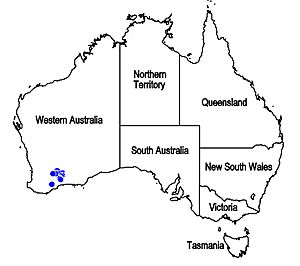Hemiphora lanata facts for kids
Quick facts for kids Hemiphora lanata |
|
|---|---|
| Scientific classification | |
| Genus: |
Hemiphora
|
| Species: |
lanata
|
 |
|
Hemiphora lanata is a beautiful flowering plant that belongs to the mint family, called Lamiaceae. You can only find this plant in the south-west part of Western Australia. It's a low-growing, spreading bush. Its branches and leaves are covered in soft, white, woolly hairs, making it look fuzzy! The flowers are deep pink or dark red. They are shaped like curved tubes with petals that spread out at the end. This plant looks a lot like another one called Hemiphora exserta. But Hemiphora lanata has more cotton-like hairs on its leaves and longer stamens.
Contents
What Hemiphora lanata Looks Like
Hemiphora lanata is a spreading shrub. It usually grows to be about 15–40 cm (6–20 in) tall. Its branches are covered with woolly hairs when they are young. But as the plant gets older, the branches become smooth (this is called glabrous).
The leaves are long and narrow, like a spear. They are 8–40 mm (0.3–2 in) long and 1–4 mm (0.04–0.2 in) wide. Their edges curve strongly downwards. Both sides of the leaves are covered with thick, woolly hairs. A similar plant, H. exserta, has rough leaves on top. Its young leaves have short, soft hairs underneath.
Flowers and How They Grow
The flowers grow either alone or in small groups of up to three. They sit on woolly stalks that are 2–4 mm (0.08–0.2 in) long. You can find them in the upper leaf axils, which are the spots where the leaves join the stem.
At the base of the flowers are special leaf-like parts called bracts. These bracts are 10–15 mm (0.4–0.6 in) long. They are smooth on the inside but very woolly on the outside. There are also shorter, smooth bracteoles.
The flower has five sepals, which are like small leaves that protect the bud. They are 8–12 mm (0.3–0.5 in) long and join together at their base to form a short tube. The sepals feel scaly on the outside. They are narrow and stay on the plant even after the petals fall off.
The petals are deep pink to dark red. They are 20–30 mm (0.8–1 in) long and form a tube that curves downwards. This tube is 13–17 mm (0.5–0.7 in) long and 5–6 mm (0.20–0.24 in) wide at the top. The petal tube has soft hairs on the outside. But it's smooth inside, except for a very hairy ring around the ovary (where the seeds will form).
The five petal lobes create two "lips." The upper lip has two short lobes. The lower lip has three lobes. The middle lobe on the bottom is almost twice as big as the other four. It's shaped like an oval or almost a circle, 9–11 mm (0.35–0.43 in) long and wide. The other lobes are more or less egg-shaped.
The four stamens (the parts that make pollen) stick out beyond the end of the petal tube. The lower pair of stamens is longer than the upper pair. (In H. exserta, the stamens are about the same length as the petal tube.)
This plant flowers from June to November. Its fruit is almost round, hairy, and about 3–4 mm (0.1–0.2 in) across.
How Hemiphora lanata Got Its Name
This plant was first officially described in 1979 by a scientist named Ahmad Abid Munir. He first called it Pityrodia exserta var. lanata. His description was published in the Adelaide Botanic Garden.
Later, in 2011, other scientists named Barry Conn, Murray Henwood, and Nicola Streiber changed its status. They decided it was its own species and moved it from the genus Pityrodia to the genus Hemiphora.
The second part of its scientific name, lanata, is a Latin word. It means "woolly," which perfectly describes the plant's fuzzy leaves and branches!
Where Hemiphora lanata Lives
Hemiphora lanata mostly grows in the area between Ravensthorpe, Hyden, and Norseman. These areas are part of the Coolgardie and Mallee biogeographic regions. It likes to grow in sandy soil or salty clay on flat plains.
This plant generally lives in more inland areas compared to H. exserta. However, sometimes you can find both species growing close to each other.
Conservation Status
The Western Australian Government's Department of Parks and Wildlife has classified Hemiphora lanata as "not threatened." This means it is not currently at risk of disappearing.

